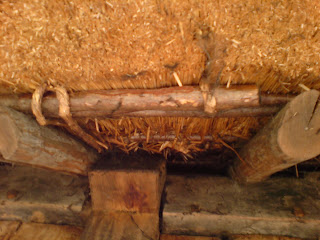Some of the Halls and Houses at West Stow
Excavations on the site have revealed human interaction there since the end of the last ice age, with evidence of stone age hunter gatherers from about 7000 years ago. There is also evidence of a neo lithic burial mound and an Iron age community complete with enclosure ditches and round houses from about 300 BC. The site was then used sporadically until it was settled by the Anglo Saxons in about 420 AD and for the next two hundred years the village grew and 'traveled' about a mile east to its present position; the site of the reconstructed village in the center of the Lark Valley.There is evidence of medieval settlement on the site but that does not concern us, for what is more interesting to me is that the site was excavated from the 1960s onwards with a view to turning the whole area into a country park. It's worth noting that a visit to West Stow not only takes in the reconstructed village, which is fascinating, but also the surrounding walks which are stunning. We are talking about getting in touch with the past in the morning and perhaps a picnic in the afternoon and all with a great walk in between. Or maybe if you can't walk far there is a great cafe on site as well as a visitors center and museum. Whichever option you choose, you can fill both your mind and bellies if you've a mind to at West Stow!
At the same time as the park was being developed the idea was put forward for a practical archaeology project on the site; the idea being to reconstruct the buildings with a view to seeing how the structures related to the evidence found by archaeologist below the ground. What is now called experimental archaeology today. They reconstructed both Saxon 'houses'; smaller structures of which there was evidence of about 70 on site all centered on shallow pits, and also 'halls'. These were larger gathering places that probably served as meeting places for individual family groups. There is evidence for at least 7 of these from Saxon times.
The 'sunken house', built in 1976
What is interesting is that because it is an ongoing archaeological experiment as well as a visitor attraction, you get to see the changing ideas about our past. One of the earliest buildings on site, but still standing today is the 'sunken house' which was built to reflect the then popular idea that Saxons lived in pits below low thatched roofs. This idea has since been proved wrong not least because the example at West Stow continually flooded. Its now thought the sunken pits excavated on many Saxon sites are the remains of cellars beneath a raised floor, but the sunken house still remains as evidence of the benefits of experimental archaeology.
Inside of the 'sunken house' showing the supposed floor level
Clicking on some images will make them larger
Clicking on some images will make them larger
And the experimentation still goes onto this day, for when one of the earlier reconstructed halls burnt down, it first gave the archaeologists a great chance to to study how a Saxon house falls and begins to rot, but also it allowed them to build a new hall in which I was lucky enough to be telling! A new hall that Incorporated all the latest ideas about Saxon house/hall building.
The new hall built in 2005

Inside the new hall
Awaiting the 'Scop', the teller of tales!

Inside the new hall
Awaiting the 'Scop', the teller of tales!
I've just mentioned two of the buildings here, because quite simply I couldn't do the rest justice. You just have to go and experience them yourselves. The reason I say experience is because the whole place is an attack on your senses. There are the sounds of wooden latches being lifted and the smells of smoke and cooking, for the fires are lit on many days of the year and there are always demonstrations of cooking, weaving and other Saxon crafts taking place. And if all that wears you out you can even have a sleep upon an authentic straw/fleece covered bed in one of the smaller houses!
What really caught my eye though was the attention to detail on site and the wonderful workmanship which planned or unplanned really brought out the beauty of the natural materials being used. From the rough split timber used to clad the outside of the hall in which I was telling......
Outer timbers of new hallThere was also the shiny and worn floor timbers in all the buildings, smoothed not with an axe, but by the footfall of many a visitor over many a year. Timbers worn smooth by modern feet, but modern feet walking in the footsteps of our ancestors!.....

Worn floor timbers at the entrance to the new hall
Many thanks to Hannah for inviting me tell at West Stow and also to Catherine, Sarah and Chrissy (I hope I got your names right!) for looking after me so well.
I leave you with a selection of other textures and materials from West Stow.....
I leave you with a selection of other textures and materials from West Stow.....
Thatch on the 'sunken house'
Some Saxon scroll work
framing a door of one of the houses
framing a door of one of the houses












No comments:
Post a Comment